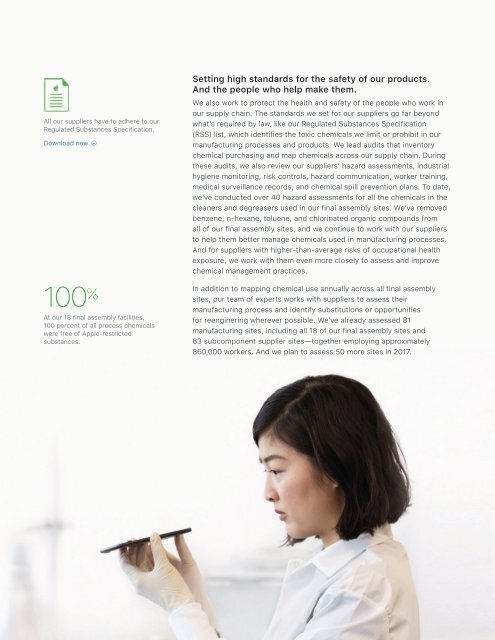Apple Environmental Responsibility Report
You also want an ePaper? Increase the reach of your titles
YUMPU automatically turns print PDFs into web optimized ePapers that Google loves.
Setting high standards for the safety of our products.<br />
And the people who help make them.<br />
All our suppliers have to adhere to our<br />
Regulated Substances Specification.<br />
Download now ↓ ⃝<br />
100 %<br />
At our 18 final assembly facilities,<br />
100 percent of all process chemicals<br />
were free of <strong>Apple</strong>-restricted<br />
substances.<br />
We also work to protect the health and safety of the people who work in<br />
our supply chain. The standards we set for our suppliers go far beyond<br />
what’s required by law, like our Regulated Substances Specification<br />
(RSS) list, which identifies the toxic chemicals we limit or prohibit in our<br />
manufacturing processes and products. We lead audits that inventory<br />
chemical purchasing and map chemicals across our supply chain. During<br />
these audits, we also review our suppliers’ hazard assessments, industrial<br />
hygiene monitoring, risk controls, hazard communication, worker training,<br />
medical surveillance records, and chemical spill prevention plans. To date,<br />
we’ve conducted over 40 hazard assessments for all the chemicals in the<br />
cleaners and degreasers used in our final assembly sites. We’ve removed<br />
benzene, n-hexane, toluene, and chlorinated organic compounds from<br />
all of our final assembly sites, and we continue to work with our suppliers<br />
to help them better manage chemicals used in manufacturing processes.<br />
And for suppliers with higher-than-average risks of occupational health<br />
exposure, we work with them even more closely to assess and improve<br />
chemical management practices.<br />
In addition to mapping chemical use annually across all final assembly<br />
sites, our team of experts works with suppliers to assess their<br />
manufacturing process and identify substitutions or opportunities<br />
for reenginering wherever possible. We’ve already assessed 81<br />
manufacturing sites, including all 18 of our final assembly sites and<br />
63 subcomponent supplier sites—together employing approximately<br />
860,000 workers. And we plan to assess 50 more sites in 2017.<br />
<strong>Environmental</strong> <strong>Responsibility</strong> <strong>Report</strong> | 2017 Progress <strong>Report</strong>, Covering FY2016<br />
30







